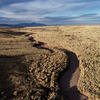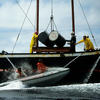You are here
Climate: a Half-Degree that Could Change Everything

The Intergovernmental Panel on Climate Change (IPCC) has just released its Special Report on the Impact of Global Warming of 1.5 °C. What is the purpose of this document?
Joël Guiot:1 During the 21st UN Climate Change Conference, the famous COP 21 held in Paris in late 2015, the 195 member countries of the United Nations Framework Convention on Climate Change (UNFCCC) made a commitment to take measures to limit global warming to 2 °C above pre-industrial levels. At the same time, a request was made to the IPCC to produce a report on the advantages of restricting warming to 1.5 °C instead of 2 °C, and the possibilities for implementing such a scenario.
Jean-Charles Hourcade:2 This report originated from the action of small island states during the COP 21 negotiations. Particularly exposed to the consequences of climate change should the global warming threshold be kept at 2 °C, these countries successfully included within the terms of the agreement the need to study the repercussions of a temperature increase of 1.5 °C.
Wolfgang Cramer:3 This new IPCC report is the response of scientists to this request. It is a very important step, expressing the COP negotiators’ recognition of the importance of basing the fight against global warming on scientific results in a much more "direct" way than before.
1.5 °C or 2 °C, is the difference so decisive?
J. G.: To make things clear, the average temperature on Earth has increased by approximately 1 °C since 1880. Yet with the melting of continental glaciers and polar icecaps, the accelerated rise in sea levels, the higher frequency of heat waves, the acidification of oceans... the effects of this warming are already very tangible. This is hardly surprising considering that there is only a 5 °C gap between a glacial and an interglacial period. As a result, we now face a major climate upheaval that is both unprecedented in its speed and global in its scope, with a rise in temperatures of 1.5 or 2 °C leading to fairly different futures.
W. C.: Between a 1.5 and 2 °C increase in temperatures, the probability is much higher of numerous systems reaching irreversible tipping point, such as the loss of coral reefs in tropical oceans, or that of the Arctic ice pack. A 2 °C rise represents a threshold in terms of change and impact, as well as in our capacity to predict and hence anticipate changes to come. Conversely, a rise of "only" 1.5 °C would markedly enhance our chances of keeping the climate situation under control.
Concretely, what are the differences between a planet at plus 1.5 °C or plus 2 °C?
J. G.:We can cite numerous examples. To start with, that half degree would translate into a factor of 2 in the number of vertebrate and plant species at risk of disappearance due to warming. Similarly, 13% of the Earth’s surface would be affected by the transformation of ecosystems at 2 °C, but only half that number at 1.5 °C. Limiting warming to 1.5 °C would also save 2 million km2 of permafrost out of 14 million, a significant gain considering that the melting of this frozen soil releases methane into the atmosphere, a greenhouse gas more potent than carbon dioxide. Another example: plus 2 °C means that one out of every 10 summers would be ice-free in the Arctic Ocean, as opposed to one out of 100 at plus 1.5 °C. Furthermore, the probability of coral ecosystems being unable to adapt to the rise in ocean acidification increases dramatically from 1.5 to 2 °C.
W.C.: Without underestimating the considerable damage from warming of 1.5 °C, that additional half degree will affect the distribution of species and diseases as well as agricultural yields and the frequency of heat waves, with far-reaching consequences for humans and their activity. To give only one example, warming of 2°C means an additional 10 centimeters in sea level rise in comparison to 1.5 °C, thereby impacting 10 million more people in coastal areas and large deltas.
This assessment is striking. Considering the current trajectory of carbon dioxide emissions, would it simply be possible to limit warming to less than 1.5 °C?
W.C.: Indeed, it is far from easy, for at the current rate of greenhouse gas emissions, we can expect an average increase in temperatures of up to 4.8 °C by 2100, compared with the period between 1986-2005. Beyond an assessment of the situation, this is the very purpose of the IPCC's special report, which demonstrates for the first time, on the basis of scientific knowledge, that it is "geophysically" possible to limit warming to 1.5 °C by 2100.
J. G.: To do so we must achieve a net-zero carbon footprint by 2030, in other words, carbon capture processes in the atmosphere will need to offset emissions at that date. Then, depending on whether the balance is more or less negative, we will be able to stabilise the climate without exceeding 1.5 °C, or by exceeding it only for a temporary period. However, the longer we wait to reach this net-zero balance the greater the rise will be, reaching 2 °C if the compensation for emissions only begins in 2050.
What mechanisms should be activated to reach this objective?
J. G.: First, it is essential to curb greenhouse gas emissions, which can be done in a number of ways: by increasing the percentage of renewables in the electricity mix, ensuring greater energy sobriety, drastically reducing industrial emissions, challenging urban sprawl, revolutionising transportation, and limiting animal-based protein consumption... Precisely, experts believe that by 2030, emissions of anthropic origin should be reduced by 40 to 50% compared to 2010 levels. At the same time, the capture of atmospheric carbon dioxide through biomass must be ennhanced, for example by extending forests or by boosting the carbon storage capacity of soils. As a last resort, the report mentions the possibility of using geoengineering techniques to limit the supply of solar heat or to bury CO2 in geological layers, while highlighting the risks of these highly technological procedures.
Would implementing such a programme mean radically changing our ways of life?
J.-C. H.: Indeed, whether the objective is 1.5 or 2 °C, any trajectory seeking to decarbonise our economy calls into question our consumption habits, technological choices and the way we organise space. But the main challenge is that such transition can only be initiated provided that it does not translate into more short-term unemployment, or into a slowdown in the eradication of poverty in developing countries. It is therefore crucial for the conditions to be in place in order for this evolution to also serve as an opportunity for limiting the global economy’s principal weaknesses, such as underinvestment in infrastructure, energy insecurity, or inequality.
What are the keys of this change?
J.-C. H.: In practice, two changes should be put in place in parallel. The first is that global taxation should be massively shifted towards carbon, in order to prevent the costs of transition from spreading to the entire economy. And each country should determine the best use for such tax products according to their national context. The second is that the international financial system should be reformed to redirect savings towards low carbon investments instead of real estate or property, for instance. May I add that in the case of a 1.5 °C threshold, the marginal cost of carbon—i.e. that of the most expensive techniques to be implemented to reach a given objective— increases by a factor of three to four compared with a 2°C threshold.
Is this possible in practice?
J.-C. H.: A great deal of research has been conducted on carbon taxation over the last 25 years. One can therefore say that the framework is in place. However, numerous details remain to be examined in order to step up its implementation and expansion to all countries. With regard to finance, recent research has shown the link between lower investment risks through public guarantees and the emergence of low-carbon assets. It is now urgent to put forward proposals that will appeal to and be implemented by the financial system. Yet that won’t be sufficient. Take for example urban renovation, which is necessary to combat energy overconsumption. It's not enough to declare it and put money on the table; we must also ensure that professionals in the construction industry make skills available, and that co-ownership associations and individuals can be convinced to swiftly follow suit. In short, it is essential to act simultaneously at every level in all the relevant sectors.
W. C.: The report is cautious in its expression, without necessarily proposing an alternative model to follow. Yet it is clear that the climate challenge requires major societal change at the global level. At the same time, by showing the range of possible solutions—whether local, national, or international—this document shows that there is no room for fatalism.
J. G.: The good news is that science has proved that there is a way forward for keeping warming below the 1.5 °C threshold. Whether that route will be taken or not is now a political question.
- 1. Centre Européen de Recherche et d'Enseignement des Géosciences de l'Environnement (CNRS / INRA / IRD / Aix-Marseille Université / Collège de France).
- 2. Centre International de Recherche sur l'Environnement et le Développement (CNRS / Ecole des Ponts ParisTech / CIRAD).
- 3. Mediterranean Institute of marine and terrestrial Biodiversity and Ecology (IMBE) CNRS / IRD / Aix-Marseille Université / Université d’Avignon.
Explore more
Author
Born in 1974, Mathieu Grousson is a scientific journalist based in France. He graduated the journalism school ESJ Lille and holds a PhD in physics.













